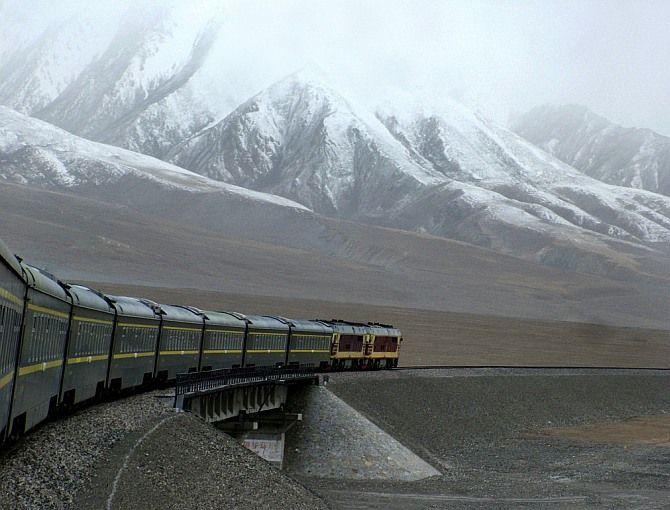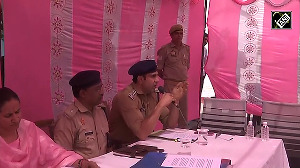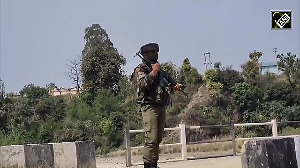Nearly two decades ago, then defence minister George Fernandes said: 'China has built roads up to the border, while there has been negligence on India's part.'
Since Fernandes uttered these brave words, what has been done on the Indian side?
The Modi Sarkar is apparently trying, but little has been achieved so far, says Claude Arpi.

One of the most important strategic developments in recent decades has been the arrival of the train on the Tibetan plateau in July 2006. Ten years later, the event has been largely ignored by the Indian media.
The train has not brought radical changes for the Tibetans alone, but for India's defence preparedness too.
For Beijing, it has been a historic date.
An article on the China Tibet Online remarks: 'Foreigners only know that the Great Wall is the seventh wonder of the world, actually, modern Chinese construction is even more amazing.'
'For example, there are the 130,000 railroad workers working in the "forbidden zone of life" on the Qinghai-Tibet plateau, with no past references, they have solved many technical problems such as building a railway through frozen soil, and achieved a miracle in human railway construction, the Qinghai-Tibet Railway.'
The train is termed the 'pride of the Chinese people.'
Ten years ago, Beijing hoped to solve several issues with the train's arrival on the plateau. It partially succeeded.
The railway indeed triggered a frenzy of infrastructure development on the plateau; the instability of the restive region has apparently been contained; a mega economic boom has been brought by tourism and as importantly, the border with India mightily reinforced.
One could add that the exploitation of natural resources of the plateau (like water and minerals) has reached new heights.
The main pretext for rapidly developing infrastructure has been tourism.
According to the ministry of environmental protection, Lhasa is one of the cities with the best air quality in China. The ministry compiled air quality data from 74 major cities. Seven of them, including Lhasa, have met the national standards for best air quality for five main pollutants.
The China Daily recently advertised the Roof of the World thus: 'Tibet with its mystery is the spiritual Garden of Eden and is longed for by travelers home and abroad. Only by stepping on the snowy plateau, can one be baptised by its splendour, culture, folklore, life, snow mountains, saint mountains, sacred lakes, residences with local characteristics and charming landscape.'
Further, tourism brings tremendous revenues to the regional government and helps in tackling the two other issues, the 'stability of the plateau and the defence of China's borders.'
In 2015, the Tibet Autonomous Region broke all records; it welcomed more than 20 million tourists. The tourism industry in the TAR generated $4.26 billion, nearly three times the figure of 2010.
Lhasa, Tibet's capital, alone saw its tourism revenue triple over the past five years to an estimated $2.51 billion. The number of tourists visiting the capital rose to 11.79 million in 2015, a 23 percent increase compared to 2014.
An article on China Tibet Online mentioned the train, 'Iron and steel road pierces into plateau tourism,' it says: 'These world class locations are like pearls embedded along the Qinghai-Tibet plateau, and now because of extensions of the Qinghai-Tibet railroad they are all linked up.'
Indeed, several extensions of the railway line are coming up.
In the wake of the 2008 unrest in Tibet, Beijing still seemed nervous. On September 7, 2015, soon after a grand parade on the occasion of the 50th anniversary of the Tibetan Autonomous Region, Yu Zhengsheng, a member of the Standing Committee of the Politburo, who was the chief guest, met a large number of representatives from the PLA and the People's Armed Police Force posted in Tibet.
Yu urged the army, the police and the judicial staff to 'crack down on separatist forces and be ready to fight a protracted battle against the 14th Dalai clique.'
It is worth noting that according to the TAR's tourist bureau more than 100,000 Tibetans were engaged in tourist services in Tibet in 2015. By providing a decent income to local Tibetans, China believes it can keep the restive population relatively happy, thereby 'stabilising' the plateau.
For Beijing, the defence of the borders are often mentioned in the Chinese media. During the Tibet Work Forum, President Xi Jinping reiterated his theory about the 'border areas.' 'Governing the border areas,' Xi said, 'is the key for governing a country, and stabilising Tibet is a priority for governing border areas.'
This speaks for itself.
Soon after the PLA entered Lhasa in September 1951, the Chinese started improving the infrastructure between China and Tibet and building new strategic roads on a war footing.
Mao Zedong knew that the only way to consolidate and 'unify' China's new colonies (Tibet and Xinjiang) was to construct a large network of roads. Priority was given to motorable roads: The Sichuan-Tibet and the Qinghai-Tibet highways. Surveying for the Tibet-Xinjiang highway cutting across Western Tibet (and the Indian territory in Ladakh) started at the end of 1951; construction began in 1953/54.
On November 29, 1954, the Xinhua news agency reported: 'The two large armies of road builders from the eastern and western section of the Sichuan-Tibet highway joined hands on November 27.' A month later, the Qinghai-Tibet highway was completed.
The construction of one feeder road leading to Nathu-la, the border pass between Sikkim and Tibet had some strange consequences. India began feeding the Chinese road workers in Tibet, sending tons of rice through this route.
Both the road network and the airports were to play a crucial role not only in what China calls the 'Liberation of Tibet,' but also in the 1962 border conflict with India.
Nearly two decades ago, then defence minister George Fernandes told a news agency: 'China has built roads up to the border while there has been negligence on India's part.'
'China,' Fernandes noted, 'has even built roads in such areas where not a single human being lives or even a blade of grass grows.'
The allusion was not lost on anybody. In 1959, while intervening in Parliament on the 'Aksai Chin road', then prime minister Jawaharlal Nehru justified why his government had taken more than two years to discover that the PLA had been building a road on the barren heights of the Aksai Chin plateau in Ladakh, saying: 'Nobody has been present there. It is a territory where not even a blade of grass grows.'
It had just come to light that a Chinese road had been built through Indian territory.
Since George Fernandes uttered these brave words, what has been done on the Indian side? The Modi Sarkar is apparently trying, but little has been achieved so far.
The new plans
According to the 13th Five-Year Plan (2016 to 2020), Lhasa should receive 24 million Chinese tourists (an annual increase of 15 percent), as well as 300,000 international tourists (an annual increase of 20 percent).
The real figures will probably exceed the plans.
For Beijing, the tourist boom is a win-win solution to solve all the problems of the plateau; the Chinese authorities have hence decided to accelerate the infrastructure construction and develop high-end tourism brands with:
1. A new railway line Lhasa-Chengdu (in Sichuan); the western leg from Lhasa to Nyingchi to be completed by 2020 will reach the Indian border.
2. A railway line to Kyirong and Nepal, probably to be continued to Kathmandu and perhaps Lumbini.
3. A second international airport in Lhasa.
4. A new terminal for Nyingchi airport.
5. A new airport in Nagchu.
6. A 4-lane highway between Lhasa and Nyingchi.
7. Improvement of national highway 219 between Tibet and Xinjiang.
All these projects have serious strategic implications for India, as ALL infrastructure built on the plateau has a dual use: Civilian and military.
On April 25, 2016, Xinhua reported that the National People's Congress discussed a new law on national defence transport. The legislation will cover the use of infrastructure for defence as well as civilian purposes.
According to the Chinese news agency: 'The new law is expected to regulate the planning, construction, management and use of resources in transportation sectors such as railways, roads, waterways, aviation, pipelines and mail services, for national defence.'
The idea is to integrate military and civilian resources and make sure that the national defence transport network is compatible with 'market and economic development.'
The time has come for India to wake up.
An antiquated 'Inner Line Permit' dating from the Raj still prevails in many border areas. It was recently announced that this may change soon, but one has to see it to believe it.
In the meantime, China is going ahead at full steam.
IMAGE: The Qinghai-Tibet Railway. Photograph: Kind courtesy Wikimedia Commons











 © 2025
© 2025